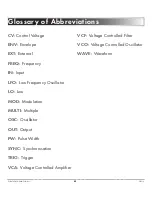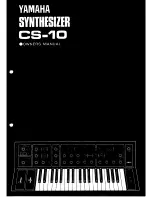
Studio Electronics Boomstar Manual
51
Panels
indefinitely sustaining the last note pressed on your MIDI keyboard, or pitch
triggered by your MIDI sequencer. Surrendering to the
MASTER
switch setting
links Envelope 2’s knob controls to Envelope 1, e.g., ENV 1’s knobs are
defeated and ENV 2’s knobs assume the Boomstar’s Attack, Decay, Sustain,
and Release values for both ENV 1 and 2: a tidy and retro sound styling
that brings to mind a certain Roland Analog keyboard of the ‘80s.
The
RELEASE
knob sets the release time. The release allows the sound to
fade out at the time set, rather than immediately upon release of a note
or key. This “final decay” takes effect after the sustain level segment of the
envelope and “does work” after the playing, triggering, or sequencing is
done.
4.2.7 X MOD - Cross Modulation
The
VCO 2 DEPTH
(Voltage Controlled Oscillator 2 Depth)
sets the amount of Audio Frequency Modulation. Use
this control in conjunction with Oscillator 2’s frequency
to create metallic, clangourous, planetary, searing
effects colors and waves. Routing VCO 2’s depth
through
VCO 1 PW
(Voltage Controlled Oscillator Pulse
Width) via the top switch setting just to the right of the knob, cross-
modulates VCO 1’s Pulse width; this was a feature found on the legendary
Prophet 5 synth. The
VCO 1 FREQ
(Voltage Controlled Oscillator 1 Frequency)
switch selection connects the frequency of VCO 1 to audio frequency
modulation, aka, cross-modulation, or X-Mod––heavy
metul
moods ahead.
4.2.8 LFO - Low Frequency Oscillator
A
tardy word about Modulation as a whole:
Modulation is the use of a control signal to create a repetitive pattern of














































